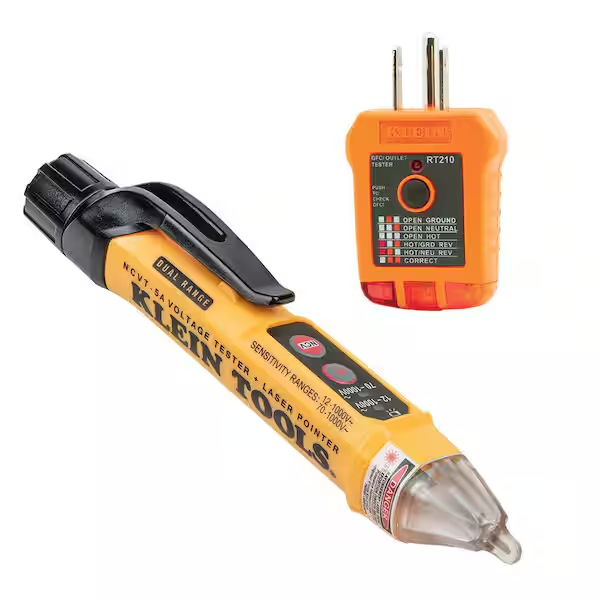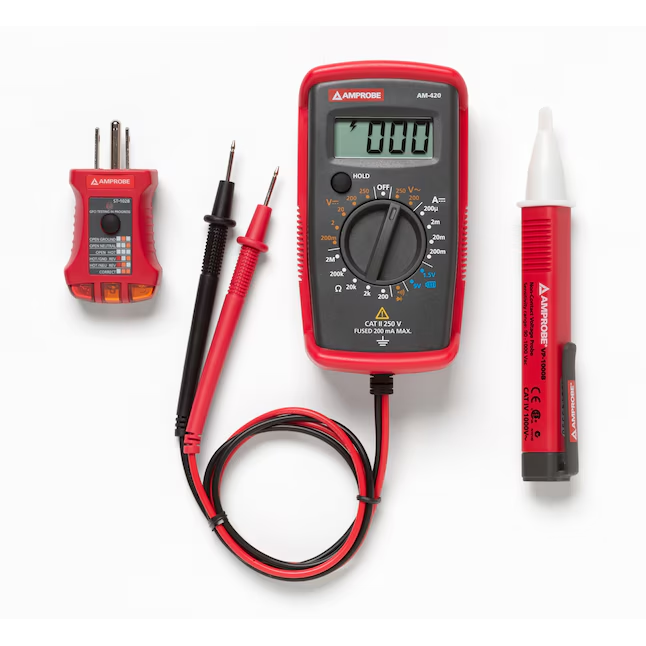An electrical tester is more than just a tool; it’s a safety guardian. Whether you’re a seasoned electrician, a DIY enthusiast, or simply someone who values home safety, owning and knowing how to use an electrical tester is crucial. It’s your first line of defense against electrical hazards, helping you identify potential problems before they become serious issues.
Understanding Electrical Testers
Electrical testers come in various types, each designed for specific tasks.
Voltage Testers:
- Basic function: Detects the presence of alternating current (AC) voltage.
- How it works: A simple circuit with a neon bulb or LED lights up when voltage is present.
- Importance: Essential for checking outlets, switches, and appliances before working on them.
Non-Contact Voltage Detectors:
- Function: Detects AC voltage without physical contact.
- How it works: Senses electromagnetic fields emitted by live wires.
- Advantages: Safer than contact testers, especially in wet conditions.
Digital Multimeters (DMMs):
- Function: Measures voltage, current, resistance, and other electrical parameters.
- How it works: Complex circuitry provides precise readings.
- Versatility: A must-have for professionals and serious DIYers.
Clamp Meters:
- Function: Measures current without breaking the circuit.
- How it works: A clamping mechanism surrounds a conductor to measure current flow.
- Use cases: Ideal for troubleshooting electrical systems and measuring motor current.
Safety First: Essential Precautions
Before using any electrical tester, prioritize safety:
- Always wear insulated gloves and safety glasses.
- Ensure the tester is in good working condition.
- Never touch live wires with your bare hands.
- Work in a well-lit area.
- Turn off power at the main breaker if necessary.

Basic Electrical Concepts
To effectively use an electrical tester, it’s helpful to understand some fundamental electrical concepts:
- Voltage: The electrical potential difference between two points.
- Current: The flow of electrical charge.
- Resistance: The opposition to the flow of current.
- Ohm’s Law: Relates voltage, current, and resistance (V = IR).

Using an Electrical Tester: Step-by-Step
Checking for Voltage:
- Turn on the tester.
- Select the appropriate voltage range.
- Carefully touch the test probes to the desired points.
- Observe the tester’s indication (light, sound, digital readout).
Measuring Current:
- Turn off the circuit.
- Access the wires.
- Open the circuit and insert the clamp meter around one of the wires.
- Turn on the power and read the current measurement.
Measuring Resistance:
- Turn off the circuit.
- Disconnect the component to be tested.
- Set the multimeter to resistance mode.
- Connect the test probes across the component and read the resistance value.
Troubleshooting Common Electrical Problems
An electrical tester can be a valuable tool for diagnosing electrical issues:
- Outlet Problems: Check for voltage on both outlets. If one outlet is dead, inspect wiring and connections.
- Circuit Breaker Trips: Use a clamp meter to measure current draw on the circuit.
- Dimming Lights: Could indicate overloaded circuits or faulty wiring. Measure voltage and current to identify the problem.
- Appliance Malfunctions: Check for power supply issues using a voltage tester. If voltage is present, the problem likely lies within the appliance.

Electrical Tester Maintenance
To ensure accurate and safe operation:
- Store the tester in a dry, protected place.
- Check the battery regularly and replace it when needed.
- Inspect the test probes for damage.
- Calibrate the multimeter periodically (if applicable).
Beyond the Basics: Advanced Applications
Electrical testers have a wider range of applications:
- Automotive Diagnostics: Check battery voltage, starter current, and charging system performance.
- Electronic Circuit Testing: Measure voltage, current, and resistance in electronic components.
- Solar Panel Installation: Verify voltage output and troubleshoot system issues.
Troubleshooting electrical problems
An electrical tester is an indispensable tool for diagnosing electrical issues. By understanding how to use it effectively, you can save time, money, and potentially prevent hazardous situations.
Basic Troubleshooting Steps
- Safety First: Always prioritize safety. Turn off power to the circuit you’re working on, wear insulated gloves, and use a non-contact voltage detector to verify power is off before proceeding.
- Identify the Problem: Clearly define the issue. Is it a tripped circuit breaker, flickering lights, a dead outlet, or something else?
- Use the Right Tester: Select the appropriate tester for the task. A voltage tester is suitable for checking for live wires, while a multimeter can measure voltage, current, and resistance.
- Check for Voltage: Use the voltage tester to verify power is present at the outlet, switch, or light fixture. If there’s no voltage, the problem might be with the circuit breaker or fuse.
- Test Continuity: Use the multimeter’s continuity setting to check for breaks in wires, switches, and outlets. A continuous tone indicates a good connection.
- Measure Voltage Drop: If you suspect a voltage drop, use the multimeter to measure voltage at different points in the circuit. A significant voltage drop indicates a problem with the wiring or a connection.
- Check for Ground Faults: Use the multimeter to test for ground faults. A ground fault occurs when electricity flows through an unintended path, such as to ground.
- Isolate the Problem: Gradually eliminate potential causes by testing different components. This process of elimination helps pinpoint the exact issue.

Benefits of using electrical testers
Electrical testers are invaluable tools that offer a multitude of benefits for both professionals and homeowners alike. Here’s a breakdown of the advantages they provide:
Safety First
- Prevent Electrical Shocks: By accurately identifying live wires and circuits, electrical testers significantly reduce the risk of accidental electrocution.
- Identify Hazards: They help detect potential electrical hazards such as faulty wiring, ground faults, and overloaded circuits, preventing fires and property damage.
- Safe Working Environment: Using an electrical tester creates a safer working environment for both the user and others in the vicinity.
Time and Money Savings
- Efficient Troubleshooting: Quickly pinpoint electrical problems, saving time and frustration.
- Reduced Repair Costs: Early detection of issues can prevent minor problems from escalating into costly repairs.
- DIY Confidence: For those comfortable with basic electrical work, testers empower them to tackle minor repairs, potentially saving money on electrician fees.
Improved Efficiency
- Accurate Measurements: Electrical testers provide precise measurements of voltage, current, resistance, and other electrical parameters, ensuring optimal system performance.
- System Optimization: By identifying imbalances or inefficiencies, testers help optimize electrical systems for better energy efficiency.
- Faster Problem Solving: With accurate data, troubleshooting becomes quicker and more effective.
Versatility
- Multiple Applications: Electrical testers can be used for a wide range of tasks, from household repairs to industrial applications.
- Adaptability: Different types of testers, such as multimeters and clamp meters, cater to various electrical testing needs.
- Professional Tool: Essential for electricians, technicians, and engineers for diagnosing and repairing electrical equipment.
Saving time and money on electrical repairs
Electrical issues can be a real pain. They’re often unexpected, potentially dangerous, and can quickly turn into costly repairs. But with a little knowledge and proactive care, you can significantly reduce the frequency and expense of these problems.
Prevention is Key
- Regular Inspections: Just like your car, your home’s electrical system needs regular check-ups. Hire a qualified electrician for periodic inspections to identify potential issues before they become major problems.
- Outlet Overload: Overloading outlets can cause fires and damage to your appliances. Avoid plugging too many devices into a single outlet. Consider using power strips with surge protection, but don’t overload them either.
- Circuit Breaker Trips: Frequent circuit breaker trips indicate an overloaded circuit. Instead of resetting it repeatedly, identify the cause and address it. It could be a faulty appliance or too many devices on one circuit.
- Outdated Wiring: Older homes may have outdated wiring that poses safety risks. If you suspect this is the case, consult an electrician for an inspection and potential upgrade.
- Proper Maintenance: Regularly clean light fixtures and replace burnt-out bulbs. This simple task can prevent electrical problems and improve energy efficiency.
DIY or Call a Pro?
Many people are tempted to tackle electrical repairs themselves to save money. While some minor tasks like replacing light switches or outlets might be within your capabilities, it’s essential to know your limits. Attempting complex repairs can be dangerous and void your home insurance.
When in doubt, call a professional electrician. They have the expertise and tools to handle the job safely and efficiently.
Choosing the Right Electrician
Finding a reliable electrician is crucial. Here are some tips:
- Check for Licenses and Insurance: Ensure the electrician is licensed and insured to protect yourself from potential liabilities.
- Read Reviews: Look for online reviews and testimonials from previous customers.
- Get Multiple Quotes: Compare prices and services from different electricians. Be wary of extremely low bids, as they might indicate subpar quality.
- Clear Communication: Discuss your needs openly and ensure you understand the electrician’s recommendations and pricing.

An electrical tester is an indispensable tool for anyone working with electricity. By understanding its functions, safety precautions, and basic electrical concepts, you can confidently tackle electrical tasks and protect yourself from hazards. Remember, when in doubt, consult a qualified electrician.


